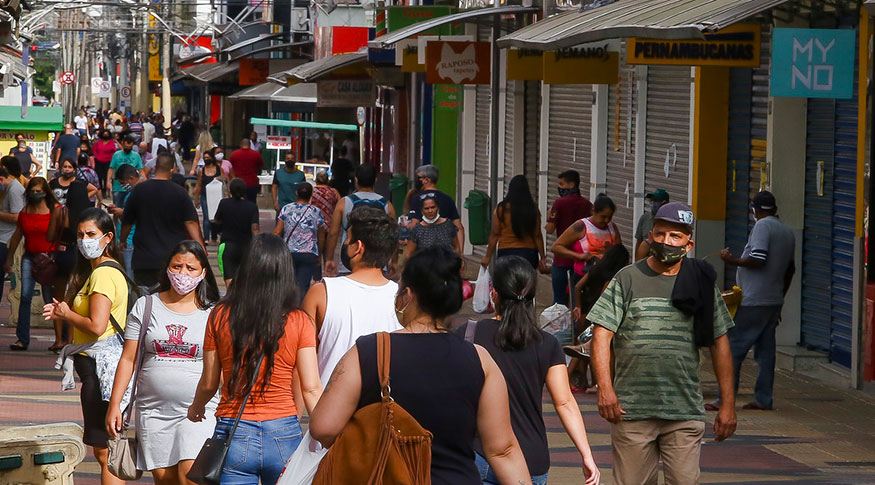Continuous PNAD
Unemployment drops to 8.7% in third quarter
October 27, 2022 09h00 AM | Last Updated: October 27, 2022 01h17 PM

The unemployment rate, which measures unemployment in Brazil, remains dropping and reached 8.7% in the quarter ended in September. This is the lowest rate since the quarter ended in June 2015 (8.4%) and it represents a drop of 0.6 percentage points (p.p.) in the comparison with the previous quarter, ended in June (9.3%), and of 3.9 p.p. over the same period of 2021 (12.6%).
The contingent of employed persons (99.3 million) grew 1.0% (more 1.0 million) in the quarter and 6.8% (more 6.3 million) in the year, beating once again the record in the time series, started in 2012. The data come from the Continuous National Household Sample Survey - Continuous PNAD, released today (27) by the IBGE.
“The unemployment rate follows the downward trend that has been noticed over the last quarters. The retraction in this rate is influenced by the maintenance of the growth of the employed population,” highlights Adriana Beringuy, the coordinator of PNAD.
The unemployed population (9.5 million persons) fell to the lowest level since the quarter ended in December 2015, having dropped 6.2% (less 621 thousand persons) in the quarter and 29.7% (less 4.0 million) in the year.
The employment-population ratio was 57.2%, the highest one since the quarter ended in October 2015, having risen 0.4 p.p. in the quarter and 3.1 p.p. in the year. The composite underutilization rate (20.1%) was the lowest one since the quarter ended in May 2016, having fallen 1.1 p.p in the quarter and 6.4 p.p. in the year. The underutilized population was of 23.4 million persons.
Contingent of workers with a formal contract remains growing
Concerning the way of insertion of workers, the survey shows that the number of those employed with a formal contract grew 1.3% in relation to the previous quarter, reaching 36.3 million persons. In the annual comparison, the contingent grew 8.2%.
The number of persons employed without a formal contract in the private sector (13.2 million persons) was the highest in the time series initiated in 2012, having remained stable in the quarter and having risen 13.0% (1.5 million persons) in the year.
The number of those employed in the public sector was a record in the time series (12.2 million), having grown 2.5% (291 thousand persons) in the quarter and 8.9% (989 thousand persons) in the year. This increase was leveraged by those employed in the public sector without a formal contract (3.1 million). It also hit the record by growing 11.6% (317 thousand persons) in the quarter and 35.4% (799 thousand persons) in the year.
“We have noticed a fast pace in the public sector over the last three quarters, mainly due to the recovery of the segment of education and health,” details the coordinator.
The informality rate was 39.4% of the employed population, against 40.0% in the previous quarter and 40.6% in the same quarter of 2021. The number of informal workers reached 39.1 million.
Public administration, defense, social security, education, human health and social services (1.8% or more 315 thousand persons) and Other services (6.8% or more 348 thousand persons) grew in the quarterly comparison. The others remained stable.
Beringuy highlights that “three activities have been standing out since June: Trade, Public administration, defense, social security, education, human health and social services and Other services. Although Trade was stable in this quarter, it still maintains a very important contingent and remains an important activity in terms of absorption of workforce, with more than 19 million persons.”
Average earnings grows both in the quarter and in the year
The Continuous PNAD released by the IBGE also shows that the usual real earnings grew for the first time since June 2020, both in the quarterly comparison (3.7%) and in the annual one (2.5%), reaching R$2,737.00.
According to the coordinator of the survey, “the growth in the real earnings is related to the the reduction of inflation, fostering real gains. The nominal earnings, which does not discount inflation, has already been growing in 2022, whereas the real was dropping. Inasmuch as inflation retracts, real earnings grow.
More about the survey
The Continuous PNAD is the main instrument to monitor workforce in Brazil. The survey sample per quarter corresponds to 211 thousand households surveyed in Brazil. Nearly two thousand interviewers work in the survey in 26 states and in the Federal District, integrated to the data collection network of more than 500 IBGE branches.
Due to the Covid-19 pandemic, the IBGE implemented data collection by telephone on March 17, 2020. In July 2021, face-to-face data collection was resumed. The id of the interviewers can be confirmed at the Answering the IBGE website or through the Call Center (0800 7218181) by checking their ID numbers, which can be requested by the informants. See PNAD data at Sidra.




















